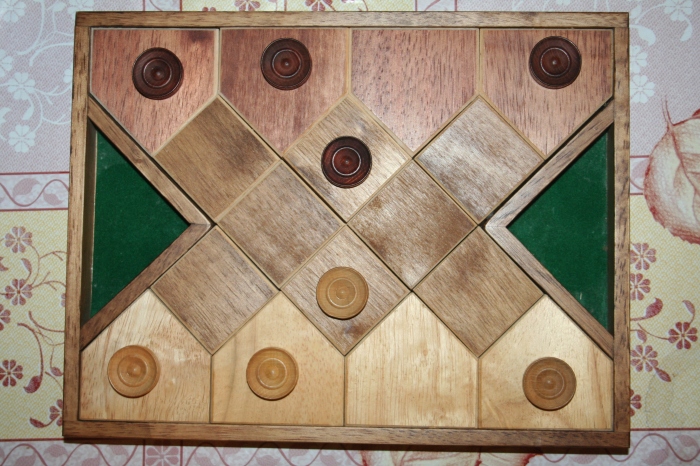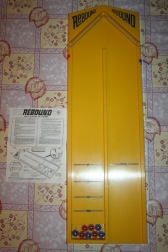Number of Players: 2
Year of Publication: Unknown
Creator: Unknown
Strategist? Don’t Plan Wars, Play Go!
Go is a strategic two player game which dates back some 3-4,000 years in age. It’s got initially very simple rules, but will probably take me the rest of my life to get anywhere close to good at it as it requires a dimension of thought I don’t believe I currently possess. I was introduced to it by a friend back in September, she tried to teach me the basics in a pub one evening, using a Chess Board and Draughts pieces. Needless to say, the outcome was a little interesting and involved me losing spectacularly and being completely confused for quite a while.

What’s in the Box:

Inside the box you’ll usually find:
- A board (I have acquired two boards for the game, as the one in the box is bent, and therefore, given the size of the pieces, fundamentally useless).
- The instructions, very handy for the point when you realize you’ve been playing one of the rules wrong for the entire game.
- 180 white playing pieces.
- 181 black playing pieces.
Playing the Game:
Objective: To surround empty areas of the board and capture your opponents pieces.

The Rules:
- Players move by playing stones on the intersections on the board with Black playing first.
- Once a stone has been played on the board it cannot then be moved unless it is captured – captured stones are removed from the board.
- To capture a stone the opposing player must closely surround it, cutting of all its “liberties”. Liberties are the four lines extending out from the intersection a piece is played on. If all four of these are blocked on the next closest intersection, that piece is captured.

- Once a space like this has been created it is called an Eye, the space in the middle of the Eye cannot be played on by the other colour player, as this move is suicidal – your piece would be captured as soon as it had been placed – however, in the event that playing this piece caused one of your opponents pieces to be captured, thus freeing up one of the Liberties for the piece in the centre of the Eye this move becomes legal.


- Stones played on the edge of the board only have three Liberties and can be captured in the same way as other pieces.
- A player can create an Army by playing one of their stones on the Liberty of another of their pieces, these are now connected and to capture them you must block all of their combined Liberties.
- Armies can be continually extended by connecting Liberties but it’s important to note that diagonal connections do not count.

- Once a player has created an Army, their opponent cannot take individual pieces, the Army must be captured as an entire unit, or not at all.
- Any Army that encloses an empty space on the board must also be captured from the inside, once all external Liberties have been surrounded the capturing player must play a stone on the available intersection(s) inside the Army to remove it from the board.

- If a position is reached where one player acknowledges that there are some stones on the board that cannot avoid being captured, their opponent can remove these stones as prisoners at the end of the game without needing to further occupy their Liberties, this can only happen if both players agree.
- Ending the Game: Theoretically a player can pass a turn, by handing over one piece from their unplayed stock to their opponent as a prisoner. Once both player pass in succession, the game is over. However, in practice, the game usually reaches a point where all available territory has been securely surrounded by one player or the other and there can be no dispute about whether or not any groups of stones can still be captured. Now the game ends by mutual agreement, and points are scored to determine who wins.
- Scoring Points: points are scored by counting up the number of empty intersections left on the board surrounded by each colour. Captured pieces also give a bonus of one point each and these two scores added together determine the winner.
- Illegal Moves: There are only two illegal moves in Go; The “Suicide Rule” and the “Rule of Ko”. The Suicide Rule forbids a player to place a piece in a location that would cause it to immediately be captured, as I said before. The Rule of Ko is much more interesting, “Ko” is a Japanese word meaning “eternity”, this rule was invented to prevent the game reaching stalemate. This rule forbids a player to move in a way that leaves the board in exactly the same position as his or her previous move.
Strategy:
Go is essentially a tactical game, and therefore probably not one i’m going to excel at any time soon, but it is very interesting to consider the different angles of play. Interestingly, games like this (and also Chess) can reveal a lot about a person. Whether you play defensively, aggressively or recklessly, it can be a challenge to restrain your natural instinct towards your chosen method of going about things in the interest of actually winning the game.
Having played the game so few times there’s not much I can give in the way of tactics, but there is one type of play that’s so well-known and used that it’s more or less become a standing play, something that features in every game.
INVULNERABLE ARMIES:
If one player has managed to create an Army, and there is an empty space inside this Army, they may intentionally place pieces inside the Army to create Eyes there. If a player manages to create an Army with two or more Eyes in the centre, this Army cannot be taken, as placing any piece here would be suicide and there is no way to simultaneously cut off all its Liberties.

History and Interesting Things:
- Although the game is thought to have originated in China it became really popular in Japan, where, in the early 17th Century, stipends were awarded to the four strongest Go players, by the Shogun. These were then later extended to their heirs, and so the four Go schools; Honinbo, Hayashi, Inoue and Yasue were founded.
- Over the following 250 years the four Go schools encouraged such rivalry that a ranking system was set up with nine grades of Go player, the highest of which is Meijin, meaning “expert”. This title was only held by one person, and only achieved if one player managed to out-class all their contemporaries.
- Meijin Dosaku is considered the best Go player in history, and was the fourth head of the Honinbo school, which was easily the most successful of the four, producing more Meijins than the other three schools put together.
- In 1868 professional Go was undermined in Japan as the Shogunate collapsed and the Emperor was returned to power.
- A game of Go once decided the future of Tibet when the Buddhist ruler at the time refused to engage in a battle and instead challenged the aggressor to a game of Go.
- Go is followed as avidly in the Far East as sporting competitions are in the West, professional players from Japan, Korea, China and Taiwan become national heroes in their home countries.
- By 500 BC in China, Go was already one of the “Four Accomplishments” that had to be mastered by a Chinese gentleman.
- In Europe the game was not played at all, despite having been described and written about by European travellers going to the Far East, until 1880.
- Britain has been playing Go for at least 100 years now, and currently our top ranking player is Matthew Macfayden (not to be confused with actor Matthew Macfadyen)
- Prior to the last 20 years, games of Go were rarely played between Go masters of different nationalities, the game has been advancing hugely in recent years, in part thanks to the internet, there are many servers for Go players of all levels now, encouraging the continued growth of the game worldwide.
For the Super-Interested…
So that’s the end of this somewhat lengthy post about Go. It currently rates 3/5, not because it’s anything less than a brilliantly concieved game, but because the tactical development involved in learning to play the game is complicated, and I think that to play well, one would actually have to study the game. So learning it is quite an undertaking, for the willing individual.
If anyone’s interested enough to actually want to learn how to play this game properly (something that i’m now trying to achieve), you could watch this video:
Further Reading:
Here’s where you’ll find all my history points, and more!
And HERE is where i’m trying to improve my limited ability to play this game!



























